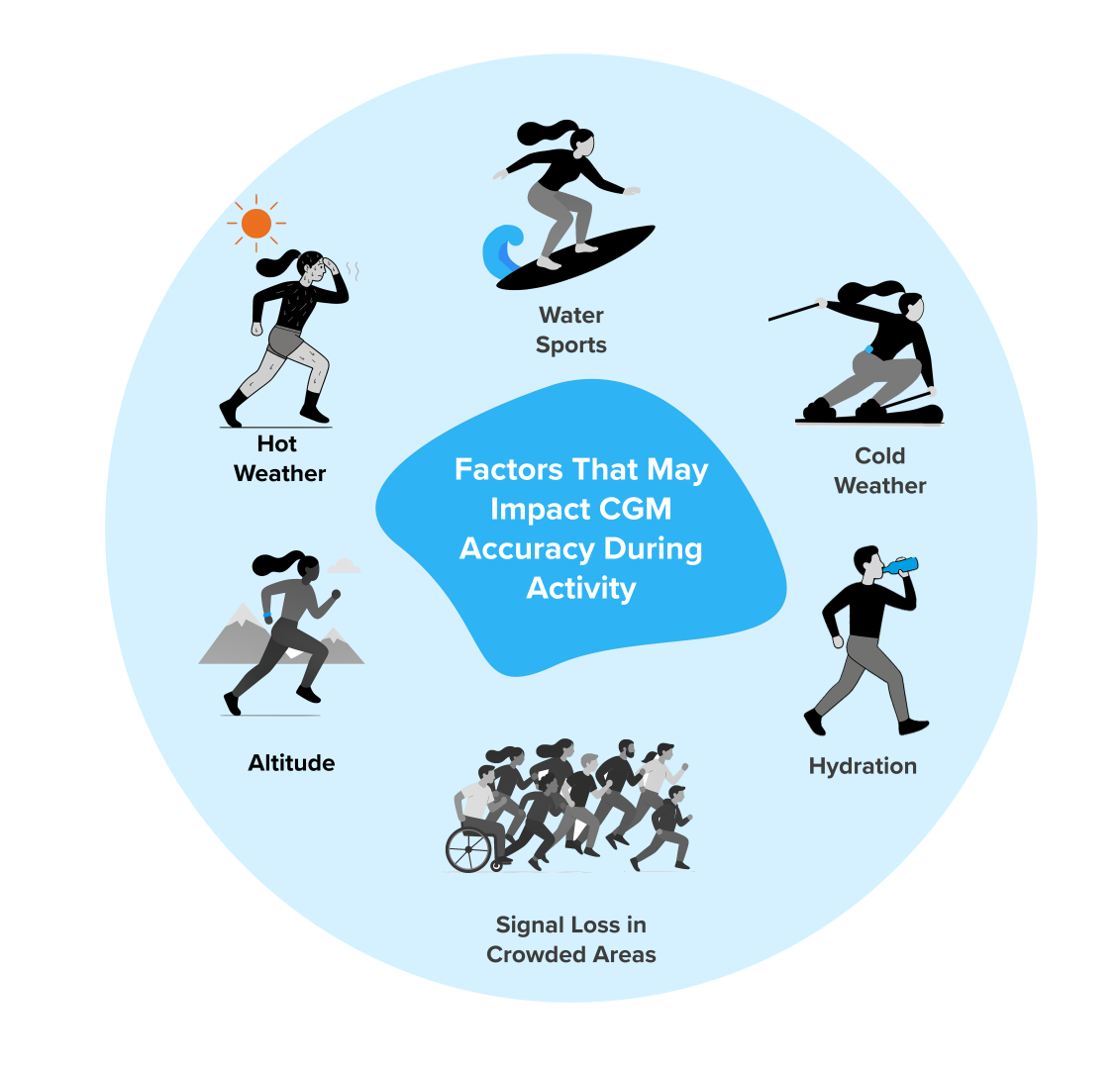Changes in temperature, altitude, and hydration status may affect CGM performance.

Physical activity is an important part of diabetes management, and CGMs can be helpful tools to understand glucose patterns and trends. However, physical activity may sometimes make your CGM readings less reliable. Things like body movement, where your sensor is placed, skin irritation, sweat, or even your device coming loose can affect your CGM readings. Changes in temperature, altitude, hydration, and the natural delay between CGM readings and blood glucose readings during activity can also play a role. Knowing about these potential challenges can help you better understand your CGM data and help you feel more confident and stay active.



References:
1. Guillot FH, Jacobs PG, Wilson LM, et al. Accuracy of the Dexcom G6 Glucose Sensor during Aerobic, Resistance, and Interval Exercise in Adults with Type 1 Diabetes. Biosensors (Basel). 2020;10(10):138. doi:10.3390/bios10100138
2. Haller MJ, Shuster JJ, Schatz D, Melker RJ. Adverse impact of temperature and humidity on blood glucose monitoring reliability: a pilot study. Diabetes Technol Ther. 2007;9(1):1-9. doi:10.1089/dia.2006.0051
3. Moser O, Mader JK, Tschakert G, et al. Accuracy of Continuous Glucose Monitoring (CGM) during Continuous and High-Intensity Interval Exercise in Patients with Type 1 Diabetes Mellitus. Nutrients. 2016;8(8):489. doi:10.3390/nu8080489
4. Fink KS, Christensen DB, Ellsworth A. Effect of high altitude on blood glucose meter performance. Diabetes Technol Ther. 2002;4(5):627-635. doi:10.1089/152091502320798259
5. El-Rifai M, Hadidi MA, Joseph H. The Accuracy of Continuous Glucose Monitors at High Altitude. Clinical Diabetology. 2023;12(1):69-70. doi:10.5603/DK.a2022.0050
6. Moser O, Zaharieva DP, Adolfsson P, et al. The use of automated insulin delivery around physical activity and exercise in type 1 diabetes: a position statement of the European Association for the Study of Diabetes (EASD) and the International Society for Pediatric and Adolescent Diabetes (ISPAD). Diabetologia. 2025;68(2):255-280. doi:10.1007/s00125-024-06308-z
7. Genua I, Sánchez-Hernandez J, Martínez MJ, et al. Accuracy of Flash Glucose Monitoring in Patients with Diabetes Mellitus on Hemodialysis and Its Relationship with Hydration Status. J Diabetes Sci Technol. 2020;15(6):1308-1312. doi:10.1177/1932296820975057
8. Bauhaus H, Erdogan P, Braun H, Thevis M. Continuous Glucose Monitoring (CGM) in Sports-A Comparison between a CGM Device and Lab-Based Glucose Analyser under Resting and Exercising Conditions in Athletes. Int J Environ Res Public Health. 2023;20(15):6440. doi:10.3390/ijerph20156440
9. Hughes MS, Kingman RS, Hsu L, Lal RA, Buckingham BA, Zaharieva DP. Swimming With the Omnipod 5 Automated Insulin Delivery System: Connectivity in the Water. Diabetes Care. 2023;46(8):e148-e150. doi:10.2337/dc23-0470
10. Yardley JE, Sigal RJ, Kenny GP, Riddell MC, Lovblom LE, Perkins BA. Point accuracy of interstitial continuous glucose monitoring during exercise in type 1 diabetes. Diabetes Technol Ther. 2013;15(1):46-49. doi:10.1089/dia.2012.0182
11. Zaharieva DP, Turksoy K, McGaugh SM, et al. Lag Time Remains with Newer Real-Time Continuous Glucose Monitoring Technology During Aerobic Exercise in Adults Living with Type 1 Diabetes. Diabetes Technol Ther. 2019;21(6):313-321. doi:10.1089/dia.2018.0364
12. Li A, Riddell MC, Potashner D, Brown RE, Aronson R. Time Lag and Accuracy of Continuous Glucose Monitoring During High Intensity Interval Training in Adults with Type 1 Diabetes. Diabetes Technol Ther. 2019;21(5):286-294. doi:10.1089/dia.2018.0387